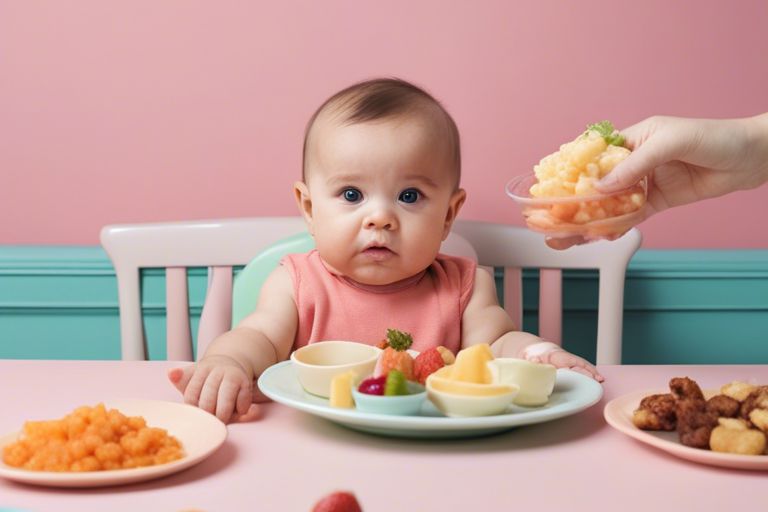tips, tricks and guides for parenthood
Many parents are embracing baby-led weaning as a positive and empowering approach to introducing solid foods to their infants. Instead of traditional spoon-feeding purees, baby-led weaning encourages infants to self-feed and explore a variety of textures and flavours right from the start. This method promotes independence and helps infants develop their motor skills and food preferences naturally. However, it is important for parents to be mindful of choking hazards and always supervise their infant during mealtime.
The time to start Baby-Led Weaning is when your little one shows signs of readiness, usually at around six months of age. Your baby should be able to sit up independently and grab objects to their mouth before starting this exciting journey of self-feeding.
When beginning Weaning, safety is the utmost priority. Here are some Essential Safety Tips to keep in mind:
Thou, always make sure to cut food into manageable pieces and supervise your baby closely.

Assuming you're ready to initiate on the exciting journey of Baby-Led Weaning, it's important to be well-prepared. For a comprehensive guide on how to get started and the best foods to introduce to your little one, check out Baby-Led Weaning: How to Start and Best BLW Foods.
To kickstart your baby's BLW journey, opt for soft, easy-to-grip foods like steamed vegetable sticks, ripe avocado slices, and lightly cooked fruit pieces. These choices allow your baby to explore textures and tastes while practising their hand-eye coordination.
Thoughtful consideration should be given to foods that pose a choking hazard, such as whole grapes, nuts, and chunks of raw vegetables. This is especially important as your baby begins to self-feed. It's crucial to avoid honey before your baby turns one, as it can contain spores that may lead to botulism in infants.
Unlike traditional weaning methods where parents decide what and how much their baby eats, baby-led weaning focuses on allowing the infant to explore and choose their own foods. Establishing a routine is key to this approach. Try to offer meals and snacks at regular times throughout the day to help your little one understand when it's time to eat.
Any parent knows that decoding your baby's cues can sometimes feel like a mystery. However, when it comes to baby-led weaning, understanding your infant's hunger and fullness cues is crucial. Look out for signs like hand-to-mouth movements, increased alertness, or turning their head away when they've had enough.
Strategies
The key to learning to recognise your infant's cues lies in observation and patience. Watch your baby closely during mealtimes and be attentive to their signals. Remember that every baby is different, so it may take some time to fully understand what your little one is trying to communicate.
Challenges may arise when your baby is exploring food for the first time through baby-led weaning, and it is natural to feel concerned about gagging and choking. However, it is necessary to differentiate between the two, as gagging is a normal part of the learning process for babies as they navigate different textures and sizes of food. It is crucial to stay calm and allow your baby to work through the gag reflex independently. Taking a baby first aid course can also provide you with the confidence and skills to handle any potential choking incidents.
Any parent begining on the baby-led weaning journey will quickly realise that mess and waste are inevitable parts of the process. While it may seem daunting at first, embracing the mess can lead to a positive and enjoyable experience for both you and your baby. Invest in a good bib, a suitable high chair, and easy-to-clean surfaces to make the clean-up process more manageable.
Waste: Recall, the mess and waste produced during meals are signs that your baby is exploring and learning about food independently. It's all part of the experience and can lead to a healthier relationship with food in the long run.
Upon reflecting on the concept of Baby-Led Weaning, it is clear that allowing infants to take the lead at mealtime has numerous benefits. Not only does it promote self-regulation and independence in eating, but it also encourages a positive relationship with food from an early age. By offering a variety of nutritious foods in an appropriate texture, parents can trust their babies to explore tastes, textures, and develop their motor skills at their own pace. Baby-Led Weaning empowers infants to listen to their hunger cues and preferences, fostering a healthy approach to food that can last a lifetime. So, embrace the mess and enjoy the journey of watching your little one discover the joy of mealtimes on their terms!
A: Baby-Led Weaning is a feeding approach where infants feed themselves from the start of their weaning journey, allowing them to explore different foods at their own pace.
A: Baby-Led Weaning can typically start around 6 months of age when your baby shows signs of readiness, such as sitting up independently and showing interest in food.
A: Baby-Led Weaning promotes self-feeding skills, allows babies to explore tastes and textures, helps develop hand-eye coordination, and encourages a positive relationship with food.
A: When done correctly, Baby-Led Weaning is safe for babies. It is important to offer appropriate foods, supervise meal times, and be mindful of potential choking hazards.
A: Encourage your baby by providing a variety of nutritious foods, allowing them to touch and explore foods with their hands, and eating together as a family to role model healthy eating habits.